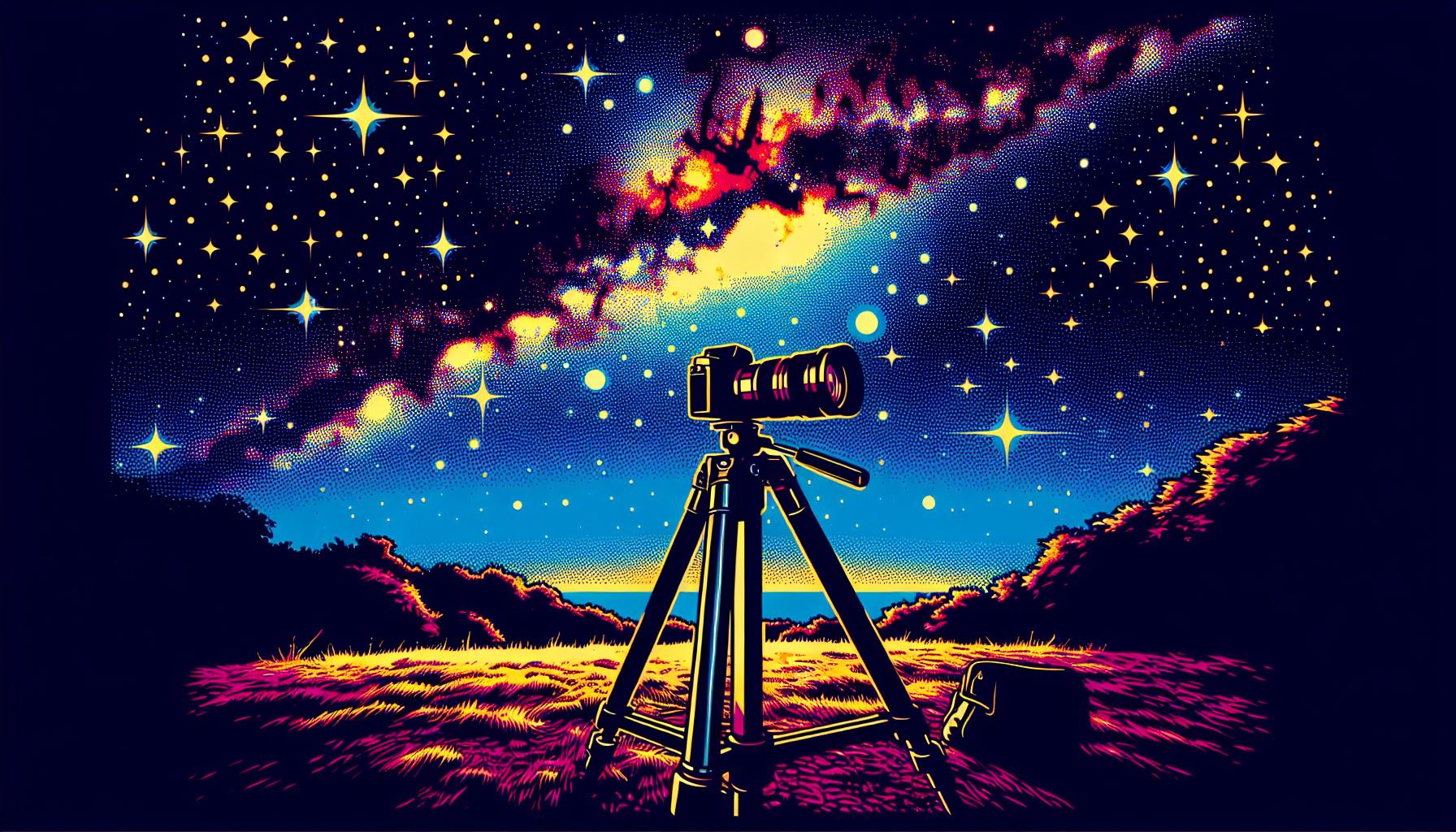This site contains affiliate links to products. I may receive a commission for purchases made through these links.
A sturdy, reliable tripod is the foundation of any astrophotography setup. It’s what keeps your camera steady during those long exposure times. Without it, you’d end up with blurry images and missed opportunities. But with so many tripods on the market, how do you know which one is right for you?
In this article, I’ll guide you through the process of choosing the perfect astrophotography tripod. I’ll highlight the key features to look for, share some of my top picks, and offer tips on how to use your tripod to get the best possible shots. Ready to reach for the stars? Let’s dive in.
Why an Astrophotography Tripod is Essential
When you’re capturing breathtaking visuals of galaxies, nebulae, or star trails, precision is key. That’s where an astrophotography tripod comes in handy. This is not an ordinary piece of equipment. It’s a specialized device specifically designed with features that will help you nail the perfect shot.
First, allows me to get technical. The term ‘Astrophotography tripod’ can be a tad misleading. It’s not only the tripod you need, but also a high-quality, equatorial mount. This mount, with its astrophotography-specific features, is designed to accommodate heavy loads and has the ability to track celestial objects. That’s a significant feature given the Earth’s rotation. This tracking ability ensures your long exposure shots remain on target.
What matters, as well, is a sturdy construction. If it’s windy or if someone accidentally bumps your setup, you do not want your camera to jerk. With an astrophotography tripod, it’s quite restful knowing its sturdy structure will go a long way to mitigate these factors.
Finally, let’s talk about the weight. Light gear may be great for hiking, but for celestial photography, you need stability, which often comes with heftier equipment. This doesn’t mean you need to haul around a gigantic weight. Astrophotography tripods come in a range of weights and sizes, and the key is to strike a balance between weight and stability.
In my next section, I will highlight the things you want to take into consideration when picking out your next or, perhaps, your first ever, astrophotography tripod. Stay tuned! It will surely come in handy when shooting under the starlit sky.
Factors to Consider When Choosing an Astrophotography Tripod
Navigating the world of astrophotography gear can be a challenge, especially when it’s time to choose your tripod. But don’t worry, I’m here to help. To find the right astrophotography tripod, pay attention to these important factors: the tripod’s load capacity, its stability, its head type, its weight, and, last but not least, its price.
Load Capacity
The load capacity of a tripod is perhaps one of the most critical aspects to carefully review. Your tripod should be capable of carrying not just your camera but also other accessories like lenses and filters. If it’s not sturdy enough, your gear could topple over, which could lead to expensive damage.
Stability
Stability is the name of the game when it comes to astrophotography. The tripod must be able to withstand ground vibrations and weather elements like wind. If the tripod is shaky or wobbly, it could ruin your long exposure shots.
Head Type
Moving on, let’s discuss about head types. In astrophotography, I personally recommend a tripod with a smooth and high-quality pan-tilt or ball head. These heads allow for severe adjustments and enable you to effortlessly follow the rotation of the night sky.
Weight
The weight of your tripod also plays a crucial role in your astrophotography ventures. If you’re traipsing through the wilderness in darkness to find the perfect shot, you won’t want to be lugging around a heavyweight tripod. At the same time, extremely lightweight tripods may lack the necessary stability.
Price
Finally, let’s talk about the price. It’s vital to find a balance between performance and how much you’re willing to spend. High-end tripods can certainly offer superior quality, but there are plenty of budget-friendly options that’ll do the job just fine. Stay tuned for my upcoming section discussing top picks that cater to a range of budgets and performance requirements.
Choosing the right tripod requires careful consideration and some trial and error – but once you’ve found that perfect match, your astrophotography will reach new heights.
Tripod Materials: Which One is Best for Astrophotography?
While considering various factors like load capacity and head type, it’s key that we delve into another essential element – tripod materials. The type of material used in manufacturing a tripod can dramatically influence its performance and lifespan.
Aluminium and carbon fibre are the primary materials used in construction of tripods, each serving their own set of pros and cons.
On one hand, aluminium tripods, the more common of the two, offer excellent stability due to their heavier weight. They tend to be more budget-friendly too, an attractive trait for beginners or those sticking to a stricter budget. However, their heavier weight can make them burdensome to carry around for extended periods.
On the other hand, carbon fibre tripods are in a league of their own. They’re notably lighter than their aluminium counterparts, making them ideal for those willing to venture out and explore new shooting locations. Additionally, their rigidity ensures a substantial level of stability, making them a preferred choice among many seasoned astrophotographers. The main drawback of carbon fibre tripods is their price. They typically come with a steeper price tag compared to aluminium ones.
Then we have hybrid tripods that blend the characteristics of both aluminium and carbon fibre materials. They attempt to strike a balance, but their effectiveness often varies greatly among different models.
With these considerations, let’s shift our attention to actual tripod models. The following section will detail some of the top tripods uniquely suited for astrophotography across a range of price points.
| Aluminium | Carbon Fibre | |
|---|---|---|
| Weight | Heavy | Light |
| Stability | High | High |
| Price | $ | $$ |
Top Picks: The Best Astrophotography Tripods in the Market
There’s no shortage of options when it comes to astrophotography tripods, but a few stand out for their exceptional quality, performance, and value for money. To help narrow down the search, I’ve handpicked some of the best astrophotography tripods currently available in the market catering to different budgets and needs. Let’s dive right into it!
1. Manfrotto 055 Carbon Fiber Tripod:
Manfrotto is one of the most reputable brands in the photography world and the 055 Carbon Fiber Tripod is a testament to their commitment to quality. It’s lightweight, exceptionally stable, and ideal for heavy equipment thanks to its high load capacity. The tripods striking balance between weight and stability comes from its carbon fiber build.
2. Neewer Carbon Fiber Tripod:
For those on a budget, the Neewer Carbon Fiber Tripod offers a compelling blend of performance and affordability. Its carbon fiber construction ensures it’s both lightweight and sturdy. It’s also incredibly compact when folded up, making it a great choice for those who plan on traveling with their equipment.
3. Vanguard Alta Pro 263AB Aluminum Tripod:
If you’re looking for affordability and stability, the Vanguard Alta Pro 263AB Aluminum Tripod is a solid bet. As an aluminum model, it’s heavier than its carbon fiber counterparts but makes up for it with its durable build and lower price point. It’s known for its exceptional load capacity and precision.
4. Zomei Q666C Carbon Fiber Portable Tripod:
The Zomei Q666C Carbon Fiber Portable Tripod is a fine selection for those seeking a portable and budget-friendly option. Impressively light and collapsible into a compact size for easy transportation, this one also offers a stable platform for your camera.
Each of these tripods has its advantages, and they all deliver in terms of stability, load capacity, and build quality. It’s all about picking the one that best fits your needs and budget.
Tips for Getting the Best Shots with Your Astrophotography Tripod
Having the right astrophotography tripod is important. But it’s equally crucial to know how to make the most of it for stellar astrophotography. Here are a few tips that I’ve gathered from my years of experience with astrophotography, tips that should take your stargazing photos to the next level.
Optimal Setup is Key. Make sure your tripod is set up correctly before you start. A tripod’s performance can significantly deteriorate if it’s not level or fully extended. It’ll be unsteady, and that can blur your long-exposure images. For the best results, ensure all three legs of the tripod are spread out evenly and the head is level.
Go for Manual Focus. When shooting stars and galaxies, I’ve found that automatic focus rarely works well. The camera has difficulty picking up on those far-off points of light. So, make sure you switch your lens to manual focus. Aim at the brightest star or planet, and adjust the focus until it’s a single point of light.
Use a Sturdy Bag. A simple yet effective method to improve your tripod’s stability is to hang a heavy bag from its center column. This extra weight can help reduce shaking from the wind. Just make sure it’s sturdy enough to handle the task.
Once you’ve mastered these tips, you’ll find that the quality of your astrophotography elevates remarkably. Trust me, your tripod is more than just a three-legged stand, it’s your foundation in astrophotography. Getting the right one, and using it properly, can make all the difference.
In the next section, we’ll delve into specific tripods and their features to help you make an informed decision when buying your next astrophotography companion. Because remember, it’s not just about the gear – it’s about how well you know how to use it.
Conclusion
Navigating the world of astrophotography tripods isn’t as daunting as it may seem. Remember, it’s all about balancing your needs with the tripod’s features. The right tripod for you depends on factors like load capacity, stability, head type, and of course, your budget. Material choice, too, plays a crucial role. Whether you go for aluminum or carbon fiber, ensure it offers the durability and stability you need. But owning an astrophotography tripod is just half the battle. You’ve got to master its use to capture those breathtaking celestial images.
From setting it up correctly to using manual focus, every detail counts. So, don’t just buy a tripod. Learn to use it well. With the right astrophotography tripod and a good grasp of how to use it, you’re well on your way to capturing the stars.
Frequently Asked Questions
What are the factors to consider when choosing an astrophotography tripod?
When selecting a tripod for astrophotography, one should consider factors like load capacity, stability, head type, weight, and price. The type of material is also crucial, with aluminum and carbon fiber being commonly used.
Why are the tripod materials important?
The materials from which a tripod is made impact its weight, sturdiness, and durability. Aluminum tripods are typically heavier but more affordable, while carbon fiber ones are lighter and more durable but cost more.
What are some tips for using an astrophotography tripod?
To get the best shots, make sure the tripod is set up correctly. Use manual focus for precision, and consider using a sturdy bag to weigh the tripod down for increased stability.
Why is it important to know how to use the tripod properly?
Knowing how to use your tripod properly ensures optimal results in astrophotography. It can help you make the best use of your tripod’s features and improve the stability and quality of your shots.






